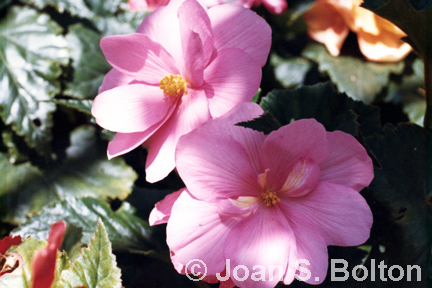
With fall-planted bulbs — daffodils, anemones, hyacinths and the like — just beginning to pop up, it may seem too soon to think about planting bulbs again.
But plant an entirely different set of bulbs in the garden this month or next, and you’ll have another round of blooming bulbs from summer through fall.
This set includes tuberous begonias, caladiums and dahlias, all of which come from fleshy tubers; gladiolus, which sprout from dry, papery corms; and calla lilies, which rise from rhizomes.
Tuberous Begonias
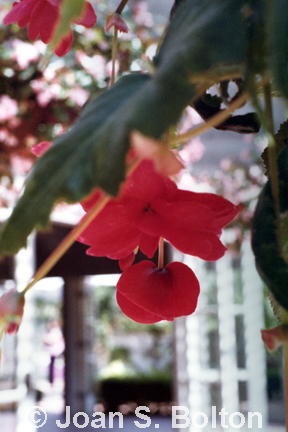
It’s amazing that such unimpressive brown disks can produce such magnificent flowers within months of planting.
Unless you have terrific drainage and are willing to roust snails daily, plant your tuberous begonias in hanging baskets or pots.
Fill the container with loose potting soil or a mix of leaf mold, coarse sand, finely ground bark and peat moss. Place the dusty brown tuber on top, dimpled side up. Cover the tuber with a thin layer of potting soil. Water thoroughly.
Then keep the soil moist through the rest of the growing season. Tuberous begonias grow best with lots of water, high humidity and filtered sunlight.
In addition, apply a mild dose of a high-nitrogen liquid fertilizer twice a month until May, to encourage the crinkled, succulent leaves to grow. Then switch to a low-nitrogen fertilizer to boost blossoming and blooming.
In the fall, after the stems fall off, lift out your tubers, dust off the dirt, and store them in a cool, dry location until the following spring.
Caladiums
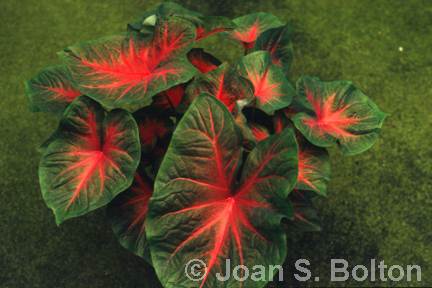
These flashy foliage plants provide a dose of the tropics, with large, heart-shaped leaves in crazy combinations of red, green and cream. Give them bright light, but keep them out of direct sun, which can burn their paper-thin leaves.
Caladiums are happiest in pots, where you can control the drainage and snails.
Start the tubers in a loose, fertile potting mix similar to what you’d use for tuberous begonias. Place the tubers bumpy side up. Cover them with 2 inches of soil, then water well.
Once your caladiums are up and growing, water them at ground level. Over-head water can spoil their leaves. When the leaves begin to fade in the fall, taper off watering. After they shrivel up, dig out the tubers, trim the dead stems, brush off the dirt and store them in a cool, dry place until spring.
Calla Lilies (Zantedeschia)
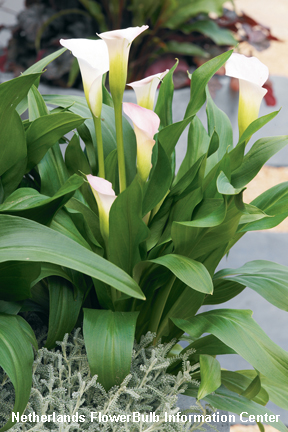
The erect, swirling white flowers of this rhizome are long-time favorites for both weddings and funerals.
They’re also among the most flexible of the summer-blooming bulbs, thriving in sun and shade, and in soils ranging from loose and well drained, to heavy clay.
Give your callas lots of water and they’ll bloom frequently. Let them go dry, and they’ll cycle in and out of bloom and dormancy.
Pant the common white calla rhizomes 6 inches deep and a foot or two apart. The dainty, dwarf hybrids, which bear pastel, speckled flowers in shades of pink, peach, yellow and red, go about 2 inches deep.
Don’t worry about digging up the rhizomes at the end of the season. Calla lilies easily naturalize on the Central Coast, forming ever-broadening clumps.
Dahlias
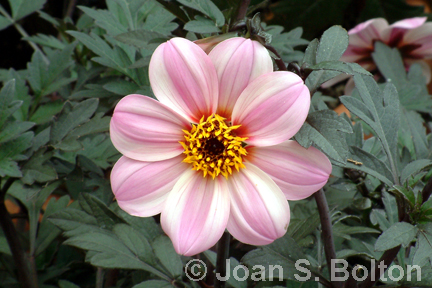
Dahlias are fussy to get started, but their show-stopping flowers are great payback.
Dig a hole about 1 foot deep and wide. Mix the excavated soil with loose potting soil, compost or other medium-textured organic material. Put 4 inches of the mix back in the hole, then place the tuber on top, with its eye up. Cover the tuber with another few inches, then water thoroughly.
As the tuber sprouts, gradually add more of the loose material until you fill the hole.
If you’re growing large, show-quality plants, put a 4 to 6-foot tall redwood stake or rebar in the hole at planting time. Pound in a stake later, and you may pierce the tuber and kill the plant.
If your dahlias decline at the end of summer, whack them to the ground and keep watering. The plants should send up new branches and resume blooming in October and November.
Some folks dig up their tubers for winter. I grow mine in raised beds and leave them alone.
Freesia
These sweetly fragrant flowers from South Africa are most commonly planted in fall. But you can put them in the ground in late winter, too, for summertime blooms.
Plant the marble-sized corms at least 2 inches deep, with their tips up, in a sunny spot. Freesias need good drainage, but not much water. Irrigate them while they’re up and growing and flowering. After they fade, you can ignore them until the following year.
Freesias also do well in pots. But be patient: the corms may take four months to bloom.
Gladiolus
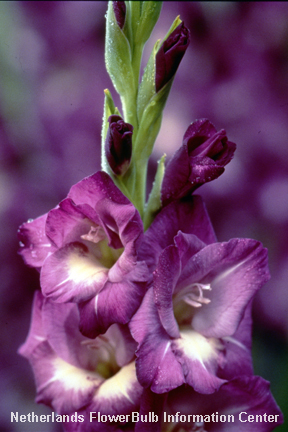
These regal, flowering swords have been staples of the cut-flower industry for years. Plant them now, and you have a good chance of avoiding thrips. The persistent, tiny pests disfigure the flowers and foliage during warmer weather.
Choose smallish corms that are about as tall as they are wide. Bigger, flatter ones may be past their prime. Plant the corms several inches deep and 4 to 6 inches apart in rich, loamy soil in full sun. I grow mine along the edges of raised vegetable beds. I will have harvested the flowers by the time my summer veggies need the space.
Water once a week, and apply a mild liquid fertilizer after five leaves have appeared, then again after the flower buds begin to swell.
Harvest each spike, just above the bottom three or four leaves, as the first flower opens. The remaining buds will open indoors.
After the plants stop blooming and the bottom leaves turn yellow, chop the stalks to the ground. Dig up the corms every few years and cut them apart to create new plants.
Glory Lily or Climbing Lily (Gloriosa rothschildiana)
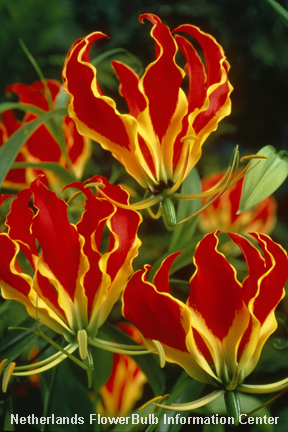
The upward-flaring flowers of this tropical vine are an incredible combination of scarlet red and banana yellow. Unusual tendrils that help the vine advance emerge from the tips of long, triangular leaves.
Glory lily thrives in sun or filtered shade. It can clamber up a 6 to 10-foot trellis or pole in a single summer, and is fine in a large container.
Place the tuber on its side in the same kind of loose mix that tuberous begonias and caladiums adore, and cover with 4 inches of soil.
After the tuber sprouts, water it regularly and apply a balanced liquid fertilizer every three weeks. In late summer as the vine finishes blooming, scale back the water. Stop completely after the foliage dies.
If your glory lily is in the ground, dig up the tuber and store it indoors. If it has been growing in a pot, store it, pot and all, in a dry, sheltered place.
Mexican Tuberose (Polianthes tuberosa)
Fragrant spikes of white flowers rise a couple of feet above clumps of grassy leaves on this native of Mexico.
Select the largest tubers possible. Plant them 2 inches deep in the ground or in a container. Water well, then let the top inch of soil dry out between waterings until the tubers sprout. Once you see green, start watering once a week.
Dig up and divide the clumps during dormancy every three to four years. The youngest, smallest bulbs may take several years to gain enough size to bloom.
≈
When to Plant
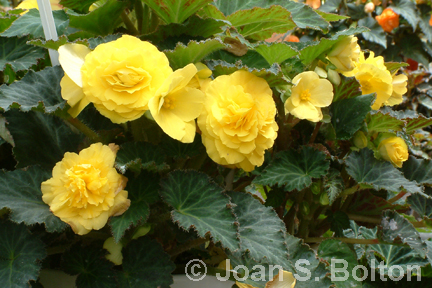
Buy your summer-blooming bulbs at local nurseries and mail-order catalogs now. But make sure your ground has dried out before you plant them, as they may perish in cold, wet soil. Instead, they like it warm, loose, and with excellent drainage.
If you don’t want to wait, pot up your bulbs.
Some, such as tuberous begonias and caladiums, will be content to live out their lives in containers. But plan to transplant others, including dahlias, gladiolus and calla lilies, which do best in the ground and may even naturalize there.
≈
Seeds of Wisdom
Most summer-flowering bulbs require watering once or twice a week, so plant them within reach of a hose or faucet.
≈
Copyright, Joan S. Bolton. All rights reserved. Reproduction of text or photos in any form is prohibited without written permission.
≈
